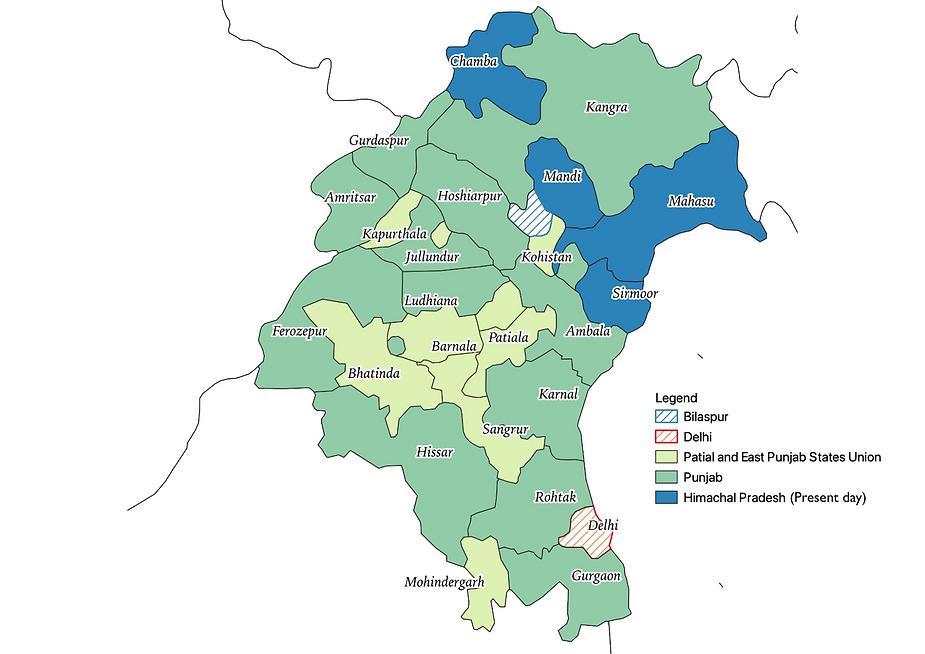Haryana
- indiastatestories
- Oct 11, 2024
- 4 min read
Updated: Jan 25
The formation of Haryana is a story deeply connected to Punjab yet marked by its distinct journey. Shaped by the profound impact of Partition in 1947, the language divide, and the events following the 1965 war, Haryana emerged as a state with a strong Hindi-majority identity. Its path reflects a transformation rooted in cultural, linguistic, and political shifts, highlighting its determination to carve out a unique place in India's history.
The journey of Haryana's formation can be traced through key historical events. It begins with the Radcliffe Line, which divided Punjab during Partition in 1947. This was followed by the creation of PEPSU (Patiala and East Punjab States Union) and the debates surrounding the demand for a Punjabi Suba. The culmination of these discussions came with the landmark Punjab Reorganisation Act of 1966, which ultimately carved out Haryana as a separate state.
The Punjab Province was the wealthiest in British India. However, during Partition, it was bifurcated into Muslim-dominant West Punjab (present-day Pakistan) and Hindu-dominant East Punjab (present-day India) as per the Radcliffe Line.
As Punjab came to terms with its new bilingual character, the economic divide between the two regions of East Punjab became evident. North-west Punjab enjoyed a more favorable climate, soil fertility, irrigation, and better infrastructure facilities, rendering the Hindi-speaking region in the South-east economically backward.
Another concern for Punjab at the time was the non-contiguity of the eight Eastern Punjab states. To the States Ministry, the immediate merger of these eight princely states with the larger state of East Punjab appeared impractical and mistimed, so they were kept separate. Since Patiala was the largest and the only viable state among the Eastern Punjab States, a union called the Patiala and East Punjab States Union (PEPSU) was created in 1948. It existed as five disconnected bits in the territory of East Punjab.
Attempts to form a government in PEPSU were unsuccessful due to the tussle between Shiromani Akali Dal (SAD) and the Indian National Congress (INC). The SAD, representing Sikh interests, demanded a consolidated Punjabi Suba comprising the Sikh-majority North-western districts.
In October 1949, as a countermeasure to the SAD's demand for Punjabi Suba, the INC in East Punjab proposed the division of the province into Punjabi and Hindi zones for educational purposes via the Sachar Formula. It was decided that the dominant language would be the medium of instruction and the other language would be a compulsory subject.
The Sachar Formula intended to retain the bilingual character of East Punjab but, by accident or design, it sharpened the divide in the province along linguistic and communal lines. As a consequence, PM Jawaharlal Nehru decided that no language would be recorded in the 1951 census for Punjab State, and a joint option Punjabi/Hindi would be shown instead.
In 1953, when the States Reorganization Commission (SRC) was formed, the Akali Dal made a strong plea for the Punjabi Suba, seeking the merger of PEPSU with contiguous Punjabi-speaking districts, rendering the Pahadi-speaking areas to Himachal and Hindi-speaking areas to Haryana. Haryana leaders also demanded separation from Punjab and plausible amalgamation with culturally similar districts of Uttar Pradesh.
The State Congress, on the other hand, proposed Maha Punjab by integrating Punjab, PEPSU, and Himachal Pradesh. On the same lines, the Arya Samaj and the Jana Sangh, the leading political organizations representing Hindus across both regions, proposed an even larger amalgamation that included Delhi as well.
Noting a lack of general support from the people in the area, the SRC dismissed the demands for a separate Punjabi Suba and Haryana. Instead, it decided to integrate both PEPSU and Himachal Pradesh into Punjab, in line with the Maha Punjab proposal. Moreover, in its report, the SRC decreed that there was no real language problem in Punjab, claiming that the superstructure of Punjabi was a dialect of western Hindi, and therefore the line of demarcation between Punjabi and Hindi was theoretical and blurred.
Post-amalgamation of different territories into Punjab in 1956, the SAD and the INC put aside their previous differences and began to work together. Their alliance, however, was short-lived, and by 1960, the SAD ended the partnership and launched a renewed movement demanding Punjabi Suba. In the meantime, the demand for a separate Haryana state also strengthened. In April 1961, the Haryana Lok Samiti was formed in association with the Arya Samaj to contest the upcoming general elections. Their campaign promoted Hindi and opposed the imposition of Punjabi as well as the economic discrimination of the region by the Punjab government.
In the next few years, India went through a difficult phase as PM Nehru passed away, and wars broke out in 1962 and 1965. The Sikhs contributed immensely in the 1965 war between India and Pakistan, resulting in growing sympathy for the division of Punjab. On 18 September 1966, the government passed the Punjab Reorganisation Act. As per the act, the Hindi-speaking districts in the South-east were consolidated into the new state of Haryana, while the Punjabi-speaking North-western districts formed the new Punjabi Suba. The northeastern hill districts merged with the existing union territory of Himachal Pradesh, and the city of Chandigarh was reconstituted as a union territory and the joint capital of Punjab and Haryana.
Sources:
Administrative Atlas of India (2011)
Origin Story of India’s States (2020) Venkata Raghavns
We the People of the States of Bharat (2022) Chopra Sanjeev.






Commentaires